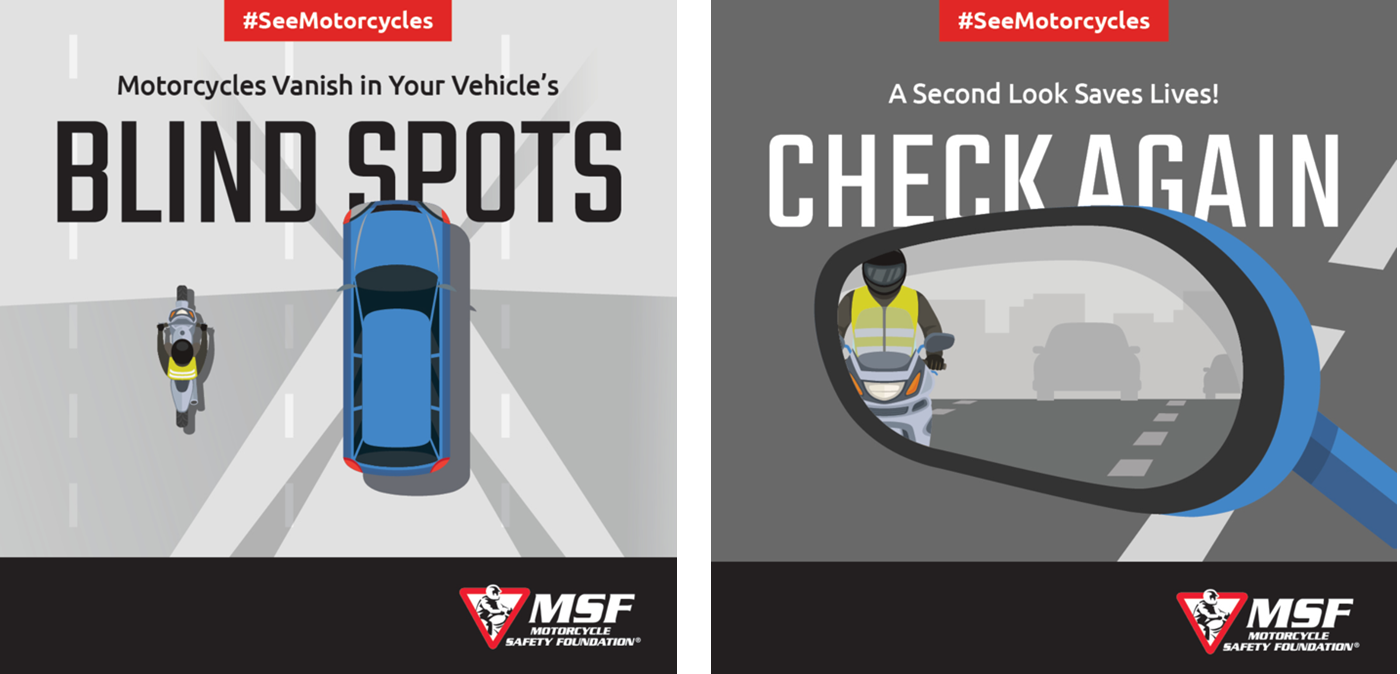May is Motorcycle Safety Awareness Month
IRVINE, Calif., May 1, 2024 — More motorcyclists will be on the roads as spring weather welcomes the riding season, and this May, during Motorcycle Safety Awareness Month, all motorists are urged to take an extra look — double check your blind spots — before turning or changing lanes, because that extra second could save a life.
“Motorcyclists, with their smaller profiles, can easily ‘vanish’ in a vehicle’s blind spots,” said Scott Schloegel, Acting President and CEO of the Motorcycle Safety Foundation. “Even though many cars today have blind-spot detection systems, they aren’t a fail-safe. So we urge car and truck drivers to actively be on the lookout for motorcyclists. Use your eyes and mirrors and look twice, especially in your blind spots, before maneuvering on the road.”
The Motorcycle Safety Foundation offers the following top tips for drivers and motorcyclists so that everyone can stay safe on the roadways.

For Car and Truck Drivers
- Actively look for motorcyclists: Motorcyclists can easily be hidden in blind spots or by other vehicles, bushes, trees, or roadway signs, so use your eyes and mirrors to check all around you before maneuvering into or around traffic.
- Focus on driving: Put down the phone; don’t let pets and passengers distract you.
- Use your turn signals: Signal your intentions. It can help others know what to expect or even alert them to get out of your way if they are in your blind spot.
- Give two-wheelers some space: Don’t tailgate or get too close when you are next to riders. Give them space to maneuver and adjust to roadway conditions.
- Keep it in the vehicle: Don’t throw trash or cigarettes out the window. Make sure cargo is secured so it doesn’t fall onto the road and become a hazard.
For Motorcycle and Scooter Riders
- Be visible: Wear bright clothing and a light-colored helmet. Always have your headlight on, day and night, and avoid riding in the blind spots of other vehicles. If possible, flash your brake light when slowing and before stopping.
- But pretend you are invisible: If you assume others can’t see you, you will tend to ride in a hyper-aware mindset and learn to notice every detail in your surroundings. Constantly search for changing conditions using the Search-Evaluate-Execute strategy (SEE) to assess and respond to hazards before you have to react to an emergency.
- Gear up every ride: Wear proper riding gear from head to toe. Full-face helmets provide the best protection. Jackets, pants, gloves, and boots specifically made for riding will generally have abrasion-resistant material and extra armor for better protection.
- Follow the rules of the road: Riding respectfully — and legally — creates a safer environment for everyone. Unexpected maneuvers could startle or confuse others and cause a crash.
- Before you ride, look over your bike: Do a pre-ride check, which includes looking over your tires and wheels, checking fluids, cables, your bike’s chassis, lights and electronics, and the stands. Use the T-CLOCS inspection checklist to help.
“According to the National Highway Traffic Administration (NHTSA) in 2022 – the last year of complete data – motorcycle fatalities were up 1.2 percent,” said Schloegel. “Motorcyclists represented 15 percent of fatalities despite only being 3 percent of the vehicles on roadways. It’s everyone’s responsibility to keep the roadways safe.”
To help get the word out on safety awareness, images and animations can be downloaded from this link: Motorcycle Safety Awareness Month.
Safety tips, booklets, and other reference materials are available at the Motorcycle Safety Foundation website, msf-usa.org. For those looking to learn to ride, earn their license, or brush up on riding skills, take a hands-on safety class. The Motorcycle Safety Foundation, the country’s leading safety resource and advocate for motorcyclists, offers courses for riders of every experience level. The MSF’s Basic RiderCourse is among the best ways to learn to ride and get licensed.


